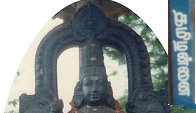Tamil Consonants. Listen to all Consonants:
Consonants are produced by touching the tongue to a location on the upper portion
of the mouth.
For example, the sound k is produced with the back part of tongue touching the velum,
the upper back part of the oral cavity. 'Pure' consonants (that is, the consonant
in isolation; more precisely, the symbol denoting the common point of articulation
among all consonant-vowel combinations)
in Tamil are written with a dot on the top of the symbol, as in க் (k), ச் (ch,
s), etc. When vowels are added to such pure consonants
to form syllables, this dot is removed and a secondary symbol representing the
vowel is included. However, there are no separate secondary symbols for certain
consonant-vowel combinations. For example,
to mark the vowel அ (a) coming after a consonant, the dot is simply removed from
the pure consonants as in க (ka), ச (ca)and so on.
There are eighteen consonants in Tamil:
five stops, six nasals, two laterals, three r sounds and two glides.
Besides these original Tamil letters, there are also six Grantha letters,
which have been added to the Tamil alphabet at a later point of time in the history
of Tamil written language to accomodate the sounds of words borrowed from
Sanskrit.
Stop sounds
Stop sounds are so called because they are produced with an abrupt release of
tongue from a firm closure at some part of the mouth. For exampe, the stop sound
த் (IPA dental???) which is called dental
stop (as in there) is produced by pressing the front portion of the tongue firmly on
the dental portion of the mouth and releasing it abruptly. The following table
distinguishes the five stop consonants and their names based on how they are
produced in various articulatory
locations.
| Letter | Pronunciation |
|
க் | k as in book, talk velar stop |
 |
ச் | c (optionally 's' in word initial
position) as in coach, beach palatal stop |
 |
ட் | T as in coat, goat aleveolar retroflex stop |
 |
| த் | t as in width (in
initial position), bathe, there (between vowels) dental stop |
 |
| ப் | p as in cup, soup bilabial stop |
 |
Nasal sounds
Nasal sounds are produced similar to how stop sounds are produced, but with an
exception of air being released through nose instead of mouth. There are six
nasals in Tamil and each of them is produced at the same place where the corresponding
stop consonants are produced. In a number of words in Tamil these nasals and
their corresponding stop sounds form a cluster.
| Letter | Pronunciation |
|
| ங் | ŋ (ng) as in strong, ping velar nasal |
|
| ஞ் | ñ (nj) as in mañana palatal nasal |
|
| ண் | ɳ (N) as in open,
then retroflex nasal |
|
| ந் |
n (n) as in nation, nose dental nasal |
|
| ன் |
n (n) as in nuke, new alveolar
nasal |
|
| ம் | m (m) as in mate, moon bilabial
nasal |
|
Lateral sounds
When the tip of the tougue is touching the pre-alveolar portion of the mouth,
the air is released through the sides of the toungue to make the lateral sounds
ல் (l as in lean, later) and ள் (L as in mole, goal). The former is called alveolar lateral and the latter is called retroflex lateral.
When producing the retroflex lateral (L), the tip of the toungue curves back
a little and makes a contact on the alveolar region of the mouth.
Fricatives - R sounds
R sounds are otherwise called fricatives, which are produced by making a friction
with the tongue and the upper portion of the palate. There are three R sounds in Tamil. They include a flapped r (ர் as in right, wrong) and a trilled R (ற் as in bore, trill). For many Tamil speakers, the distinction between
a flapped r and a trilled r is no longer made in pronunciation (though, of course,
it is relevant in the written language). In addition to these fricatives,
there is a retroflex frictionless
continuent ழ் (as in America; though note that Tamil does not have the lip rounding present in 'America').
The flapped r is produced by a tap on the alveolar part of the mouth with the tip of the tongue;
the trilled r on the ohter hand is produced with a vibration of the tip of the tongue on the
alveolar region of the mouth; and the retroflex frictionless continuent sound
(ழ்) is produced by sliding the tongue from the middle of the mouth through the
upper palate.
Glides
There are two glide sounds in Tamil namely y (ய் as in yoke and
your) and v (வ் as in vote, where). ய் is called palatal
glide and is produced with the middle part of the tongue sliding gently over the
middle portion of the palate; and வ் is called labio dental glide, which is
produced with the lower lip sliding over the upper portion of the teeth.
Grantha letters
During the medieval period Sanskrit
was written in Southern India using a special set of characters
called Grantha letters. The Grantha letters were
mainly used to write the rules and conducts of
temple rituals and rites, which are
latter called Agamas.
However, after Tamil developed its own script during
the 1st century A.D., it retained some of the Grantha letters to represent
some
of the special Sanskrit
sounds in Tamil.
There was a period during the Pallava reign between
1st
and 6th century A.D. both the Tamil script and the Grantha script must
have co-existed.
The Grantha
script is current only in the Agamic literatures
which are readable
only by the Temple priests.
Following six Grantha letters are used to accomodate
the Sanskrit words
in Tamil. Thus, any word with these letters in Tamil
are, presumably, borrowed and are
not indigenous.

